Automobile accidents are the number one cause of workplace fatalities in the United States. In Virginia, 775 individuals lost their lives in automobile crashes in 2012 – that’s nearly two people a day. In the same year, more than 123,000 crashes took place on Virginia’s roadways – that’s one every 4.26 minutes.
To increase awareness of defensive driving practices among VML Insurance Programs (VMLIP) members, in 2009 VMLIP created the Where the Rubber Meets the Road (WTRMTR) campaign. The campaign was created with financial support from VMLIP liability reinsurance carrier ACE. Through the program, VMLIP participating members – including cities, towns, schools, authorities and more – trained at least 90 percent of their drivers using the National Safety Council defensive driving curriculum. Results for members who participated during the first years of the campaign are promising – VMLIP has seen a 12 percent reduction in claims and a 27 percent reduction in the overall cost of auto liability claims with these members.
Through the program, VMLIP participating members – including cities, towns, schools, authorities and more – trained at least 90 percent of their drivers using the National Safety Council defensive driving curriculum. Results for members who participated during the first years of the campaign are promising – VMLIP has seen a 12 percent reduction in claims and a 27 percent reduction in the overall cost of auto liability claims with these members.
What’s more important, however, is that since 2010 nearly 22,000 drivers have received defensive driving training through the WTRMTR campaign – that’s 22,000 safer drivers on Virginia’s roadways.
Even if your employer isn’t participating in the WTRMTR program, there are a few simple things you can do today to increase the safety of your driving.
Vehicle Mirror Adjustment
The National Highway Traffic Safety Administration (NHTSA) estimates that about 630,000 lane change/merge (LCM) accidents occur each year. A NHTSA study found that about 60 percent of drivers involved in these crashes did not see the other vehicle, and about 30 percent misjudged the position or speed of the other vehicle.
Many drivers position their side mirrors by adjusting them until the side view of the vehicle was just in view while sitting in the driver’s seat.
This method still leaves dangerous blind spots.
Outside mirrors should be positioned so that the driver does not view the side of the vehicle. This position allows a trailing vehicle to be observed immediately after their view is lost from the inside center rear-view mirror; assuming that this center mirror is properly adjusted.
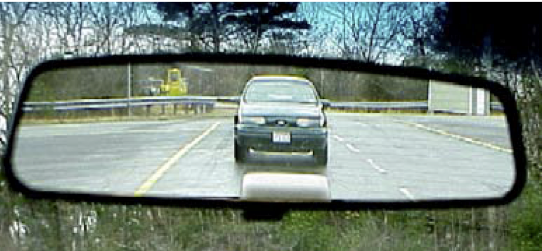 1. Adjust the rear-view mirror to give you a view directly to the rear. Position it so that it covers your best view straight out the rear window.
1. Adjust the rear-view mirror to give you a view directly to the rear. Position it so that it covers your best view straight out the rear window.
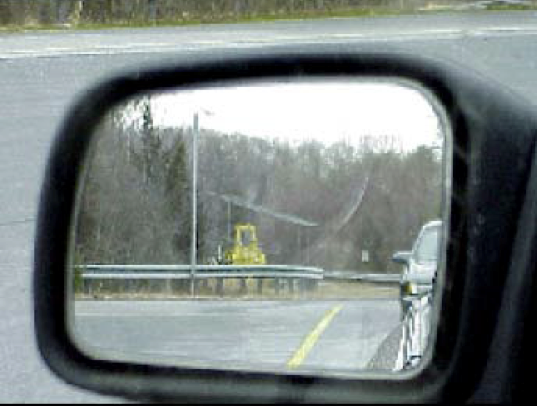 2. Lean your head until it almost touches the driver’s side window. Then, adjust your left side mirrors so that you can just barely see the side of your car. Aiming mirrors down will decrease the blind spot.
2. Lean your head until it almost touches the driver’s side window. Then, adjust your left side mirrors so that you can just barely see the side of your car. Aiming mirrors down will decrease the blind spot.
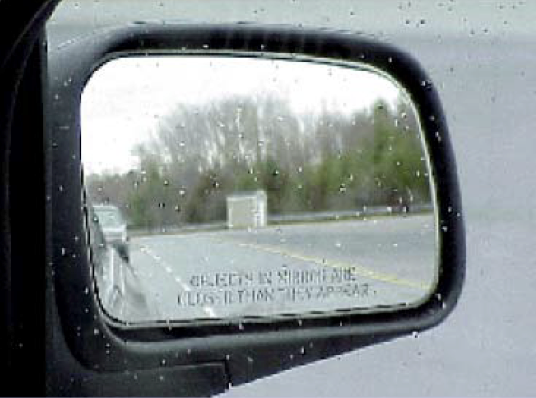 3. Lean your head to the right towards the middle of the car and adjust the right side mirror so that you can just barely see the right side of your car. Aiming mirrors down will decrease the blind spot.
3. Lean your head to the right towards the middle of the car and adjust the right side mirror so that you can just barely see the right side of your car. Aiming mirrors down will decrease the blind spot.
You should NOT be able to see the side of your car when your head is upright.
Check for blind spots by doing the following:
While driving along a four-lane road in the right lane, note a vehicle in the left lane coming up to pass you from behind. Without moving your head, glance in the rear-view mirror and follow it as it approaches your car in the left lane. Just before it disappears from your view in the rear-view mirror, glance to the left side mirror. There it is. Now follow that vehicle in the side mirror as it begins to pass you.
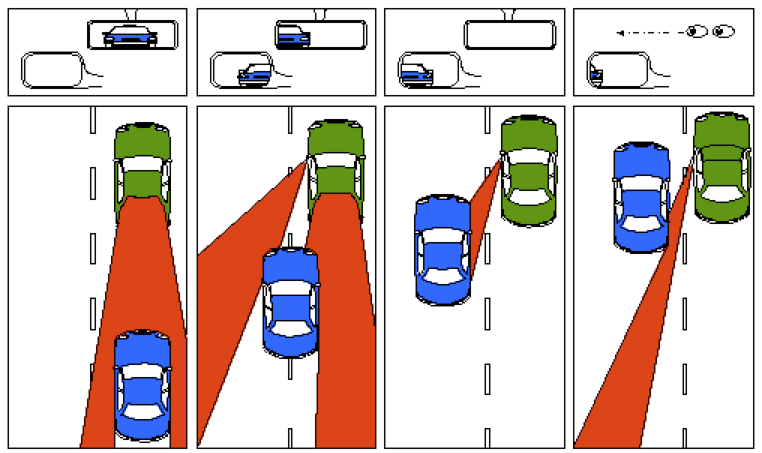 Then, just before it disappears from the side mirror, you should see it with your peripheral vision. Notice that without even turning your head, you never had a blind spot. Then try it with the right side mirror. Watch as you pass a vehicle traveling in the right lane go from your peripheral vision, to your right side mirror, to your rear-view mirror. Again, no blind spot. If there is a blind spot for even a fraction of a second, your side mirror adjustment needs some fine-tuning.
Then, just before it disappears from the side mirror, you should see it with your peripheral vision. Notice that without even turning your head, you never had a blind spot. Then try it with the right side mirror. Watch as you pass a vehicle traveling in the right lane go from your peripheral vision, to your right side mirror, to your rear-view mirror. Again, no blind spot. If there is a blind spot for even a fraction of a second, your side mirror adjustment needs some fine-tuning.
Tire pressure
A great tire can perform like an awful tire if it is not maintained properly. Understanding and ensuring basic tire maintenance for the vehicle you drive is critical in all weather conditions.
Studies of tire safety show that maintaining proper tire pressure, observing tire and vehicle load limits, inspecting tires for wear, punctures and other irregularities are the most important things you can do to avoid poor tire performance and or tire failure. These basic, but important, actions can:
- Improve vehicle traction, handling and stopping.
- Help protect you and others from avoidable breakdowns and crashes.
- Improve fuel economy.
- Increase the life of your tires.
Tire information placards such as the example below contain information on tires and load limits. These labels indicate the vehicle manufacturer’s information including:
- Recommended tire size
- Recommended tire inflation pressure (usually given in PSI cold)
- Gross vehicle weight rating (GVWR):
- Gross axle weight ratings (GAWR) for front and rear axles:
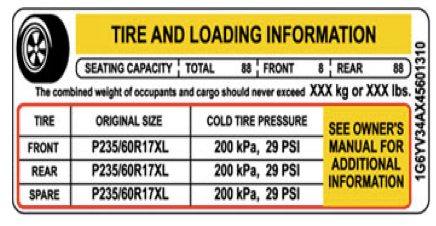 Placards are permanently attached to the vehicle door edge, doorpost, glove-box door, or inside of the trunk lid. You can also find the recommended tire pressure and load limit for your vehicle in the vehicle owner’s manual.
Placards are permanently attached to the vehicle door edge, doorpost, glove-box door, or inside of the trunk lid. You can also find the recommended tire pressure and load limit for your vehicle in the vehicle owner’s manual.
Don’t confuse the “maximum tire pressure” listed on the sidewall of the tire with the “recommended tire pressure” provided by the manufacturer of the vehicle. The recommended tire pressure is what all tires should maintain.
Checking Tire Pressure
It is important to check your vehicle’s tire pressure at least once a month for the following reasons:
- Most tires may naturally lose air over time.
- Tires can lose air suddenly if you drive over a pothole or other object or if you strike the curb when parking.
- With radial tires, it is usually not possible to determine under inflation by visual inspection.
The WTRMTR curriculum covers much more than these tips; however, mirror and tire safety are key components to preventing accidents on the road.
The WTRMTR campaign will recognize service awards and milestone achievements February 27 at The Place at Innsbrook. For more information on how your entity can take part in this campaign, contact your safety consultant at (800) 963-6800.
VMLIP offers more than just coverage. We are partners in risk management. How does your insurer stack up? Having all lines of coverage with VMLIP ensures that your organization is receiving comprehensive coverage and a wide variety of value-added services tailored to Virginia’s local governmental entities. Call for a quote today: (800) 963-6800. For more information on VMLIP visit: www.vrsa.us or follow us on Facebook.
** VMLIP blog postings are offered for VMLIP members to utilize in strengthening their risk management efforts. See copyright information for clarification on sharing this information.


